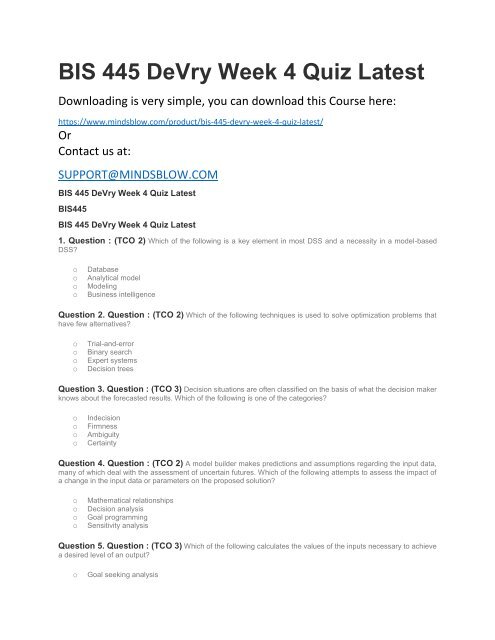BIS 445 DeVry Week 4 Quiz Latest
Create successful ePaper yourself
Turn your PDF publications into a flip-book with our unique Google optimized e-Paper software.
<strong>BIS</strong> <strong>445</strong> <strong>DeVry</strong> <strong>Week</strong> 4 <strong>Quiz</strong> <strong>Latest</strong><br />
Downloading is very simple, you can download this Course here:<br />
https://www.mindsblow.com/product/bis-<strong>445</strong>-devry-week-4-quiz-latest/<br />
Or<br />
Contact us at:<br />
SUPPORT@MINDSBLOW.COM<br />
<strong>BIS</strong> <strong>445</strong> <strong>DeVry</strong> <strong>Week</strong> 4 <strong>Quiz</strong> <strong>Latest</strong><br />
<strong>BIS</strong><strong>445</strong><br />
<strong>BIS</strong> <strong>445</strong> <strong>DeVry</strong> <strong>Week</strong> 4 <strong>Quiz</strong> <strong>Latest</strong><br />
1. Question : (TCO 2) Which of the following is a key element in most DSS and a necessity in a model-based<br />
DSS?<br />
o<br />
o<br />
o<br />
o<br />
Database<br />
Analytical model<br />
Modeling<br />
Business intelligence<br />
Question 2. Question : (TCO 2) Which of the following techniques is used to solve optimization problems that<br />
have few alternatives?<br />
o<br />
o<br />
o<br />
o<br />
Trial-and-error<br />
Binary search<br />
Expert systems<br />
Decision trees<br />
Question 3. Question : (TCO 3) Decision situations are often classified on the basis of what the decision maker<br />
knows about the forecasted results. Which of the following is one of the categories?<br />
o<br />
o<br />
o<br />
o<br />
Indecision<br />
Firmness<br />
Ambiguity<br />
Certainty<br />
Question 4. Question : (TCO 2) A model builder makes predictions and assumptions regarding the input data,<br />
many of which deal with the assessment of uncertain futures. Which of the following attempts to assess the impact of<br />
a change in the input data or parameters on the proposed solution?<br />
o<br />
o<br />
o<br />
o<br />
Mathematical relationships<br />
Decision analysis<br />
Goal programming<br />
Sensitivity analysis<br />
Question 5. Question : (TCO 3) Which of the following calculates the values of the inputs necessary to achieve<br />
a desired level of an output?<br />
o<br />
Goal seeking analysis
o<br />
o<br />
o<br />
Decision analysis<br />
Trial-and-error<br />
Sensitivity analysis<br />
Question 6. Question : (TCO 2) Data mining is tightly positioned at the intersection of many disciplines. Those<br />
disciplines include all of the following, except:<br />
o<br />
o<br />
o<br />
o<br />
management science.<br />
statistics.<br />
information systems and databases.<br />
logistics.<br />
Question 7. Question : (TCO 3) Which of the following packages are preprogrammed (sometimes called readymade)<br />
models and optimization systems that sometimes serve as building blocks for other quantitative models?<br />
o<br />
o<br />
o<br />
o<br />
Quantitative software<br />
Qualitative software<br />
Development tool<br />
Application<br />
Question 8. Question : (TCO 3) On the commercial side, the most common use of data mining has been in<br />
________ sectors.<br />
o<br />
o<br />
o<br />
o<br />
manufacturing and heath care<br />
finance, retail, and health care<br />
online retail and government<br />
R&D and scientific<br />
Question 9. Question : (TCO 2) What is a major characteristic of data mining?<br />
o<br />
o<br />
o<br />
o<br />
Data mining tools are readily combined with spreadsheets and other software development tools.<br />
Because of the large amounts of data and massive search efforts, it is sometimes necessary to use serial<br />
processing for data mining.<br />
Data are often buried within numerous small and large databases, which sometimes contain data from several<br />
years.<br />
The miner needs sophisticated programming skills.<br />
Question 10. Question : (TCO 3) Data that has a meaningful, or nonarbitrary, zero point is ________ data.<br />
o<br />
o<br />
o<br />
o<br />
categorical<br />
nominal<br />
interval<br />
ratio<br />
Question 11. Question : (TCO 3) Data mining seeks to identify patterns in the data. All of the following are major<br />
types of patterns, except:<br />
o<br />
o<br />
o<br />
o<br />
associations.<br />
regression.<br />
predictions.<br />
clusters.<br />
Question 12. Question : (TCO 3) ________ are, essentially, a hierarchy of if-then statements. They are most<br />
appropriate for categorical and interval data.<br />
o<br />
Neural nets
o<br />
o<br />
o<br />
Clusters<br />
Decision trees<br />
Time-series<br />
Question 13. Question : (TCO 2) The simple split methodology splits the data into two mutually exclusive subsets<br />
called a ________ set and a ________ set.<br />
o<br />
o<br />
o<br />
o<br />
training; test<br />
positive; negative<br />
holdout; training<br />
matrix; test<br />
Question 14. Question : (TCO 3) A good question to ask with respect to the patterns/relationships that<br />
association rule mining can discover is, "Are all association rules interesting and useful?" In order to answer such a<br />
question, association rule mining uses two common metrics: ________ and ________.<br />
o<br />
o<br />
o<br />
o<br />
mean; median<br />
support; confidence<br />
standard deviation; confidence interval<br />
regression; distance measure<br />
Question 15. Question : (TCO 3) ________ is a decision making method that analyzes the risk associated with<br />
different alternatives.<br />
o<br />
o<br />
o<br />
o<br />
Goal seeking<br />
What-if analysis<br />
Risk analysis<br />
Risk matrix

















